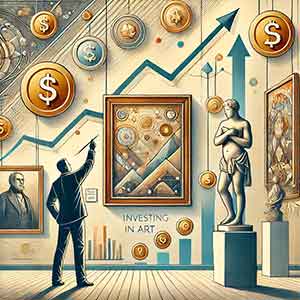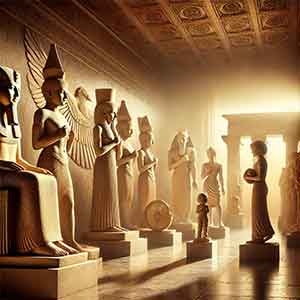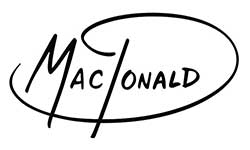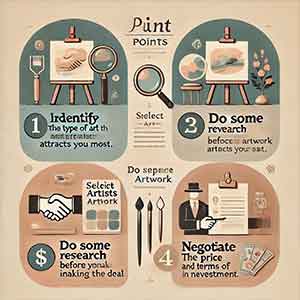What is an Investment in Art?
 When deciding where to invest your money, there are few things more satisfying, profitable, fun, and rewarding than a beautiful piece of art. Investing in a work of art is not just an enjoyable way to make money; it is also an investment in the artist and in human culture itself.
When deciding where to invest your money, there are few things more satisfying, profitable, fun, and rewarding than a beautiful piece of art. Investing in a work of art is not just an enjoyable way to make money; it is also an investment in the artist and in human culture itself.
Much like music and storytelling, visual arts have been a universal and integral part of human culture since humans began assembling tens of thousands of years ago—the earliest examples of cave paintings date to around forty thousand years ago. The caves are in numerous diverse locations throughout the world. The ones in Europe and Asia cradled the very beginnings of human civilization. Visual art such as sculpture making, particularly cave painting, predates the earliest evidence of writing and even agriculture by thousands of years. Art is unique to its culture, time and place of creation, and the artist and artistic methods used.
Investing in art is much more than buying or selling beautiful paintings for your walls; it is investing in history and culture. Even a new painting will become a piece of history before the paint dries.
Great art is timeless, and its monetary and cultural value will likely increase if it is well preserved. After forty thousand years, humans still view paintings created by artists who died long before the wooly mammoth went extinct.
Money can be reprinted, and more gold can be mined from the earth, but each piece of art is unique, and nothing can ever reproduce something created by the creative human spirit.
Traditional Art Investment
Traditionally, purchasing or funding a piece of visual art was considered an investment in beauty, religion, and/or culture. Many of the earliest and most famous art pieces were created for religious purposes, to venerate ancestors, gods, or spirits.
Some of the earliest and arguably most influential patrons of the arts were the pharaohs of ancient Egypt, who spent large portions of their kingdom’s treasury on massive art projects. Religion and culture were inseparable in ancient Egypt, and this is reflected in their art. Pharaohs and artists competed with one another and their predecessors to create the most impressive and beautiful artistic pieces for their gods.
Statues and images created four or five thousand years ago are still objects of wonder and nearly priceless. For example, the decoration on the walls in the tombs of the pharaohs is incredibly well preserved, and people still travel across continents to admire the beauty of this ancient art today. Art truly is immortal; one must only look at the extraordinary works created in ancient Egypt, China, and Greece to understand their enduring beauty, not to mention their great historical and cultural value, let alone their billions of dollars in value.
decoration on the walls in the tombs of the pharaohs is incredibly well preserved, and people still travel across continents to admire the beauty of this ancient art today. Art truly is immortal; one must only look at the extraordinary works created in ancient Egypt, China, and Greece to understand their enduring beauty, not to mention their great historical and cultural value, let alone their billions of dollars in value.
Art and religion went hand in hand in ancient times, and much of the early art depicted gods, monsters, and mythology. Since very few people were literate, these images allowed people to see depictions of their history and mythology being played out on the sides of pottery or in great mosaics and frescoes that decorated the inside of important public and religious buildings. Wealthy investors brought religious and secular prestige to themselves by funding and backing different and sometimes competing artistic projects.
Because artistic training and supplies were expensive, most people throughout history could not afford to purchase much other than the necessities to get by. Buying paintings became something only either groups, such as the Catholic Church or wealthy private investors, could afford. Therefore, much of art throughout history was either found in grand cathedrals, such as the world-famous Sistine Chapel in the Vatican, Rome, or in the private manors and castles of the wealthy nobility.
The first major change to this status quo was the Protestant Reformation when the Catholic Church lost much of its former power in countries like the German states and England. With the Catholic Church’s power waning in many parts of Europe, other institutions and groups stepped in to fill the gap, and as a result, art became more secular.
 The second significant change was the waning power of the nobility and the rise of the wealthy and upper middle classes near the end of the Enlightenment period and early Industrial Revolution. Events such as the French Revolution and the rise and fall of Napoleon Bonaparte changed the political landscape of Europe. Valuable paintings that had once belonged to now deposed lords and kings came into the public market, and institutions like the famous Louvre Museum in Paris became open to the public.
The second significant change was the waning power of the nobility and the rise of the wealthy and upper middle classes near the end of the Enlightenment period and early Industrial Revolution. Events such as the French Revolution and the rise and fall of Napoleon Bonaparte changed the political landscape of Europe. Valuable paintings that had once belonged to now deposed lords and kings came into the public market, and institutions like the famous Louvre Museum in Paris became open to the public.
The Three Basic Types of Art Investors
The lack of market transparency, liquidity, and high art costs have generally limited participation in fine art investment to a select class of super-wealthy investors, leaving out most investors. However, investing in art has broadened into three basic categories: the super wealthy, the wealthy, and the modest investor.
The Super Wealthy
Only a select few art investors fall into the super-wealthy category with the financial wherewithal to invest tens of millions of dollars in art. Wealthy investors deal with works by master artists such as Van Gogh, Picasso, Salvador Dali, Jackson Pollock, and Andy Warhol. These paintings rarely appear on the market but can sometimes be found in auctions like Christie’s or Sotheby’s. This is a very speculative area of investing, and literal fortunes have been made and lost.
The Wealthy
The next level of art investment is for the wealthy. Generally, these paintings fall between hundreds of thousands of dollars to a million or more.
These works are generally less sought-after paintings or rare prints by famous masters. When an artist dies, his or her paintings can dramatically increase in value, making them only available to the wealthy investor. Only a few living artists can command paintings in this investment range.
The Modest Art Investor
The majority of investors are modest, with investments ranging from a few thousand dollars to upwards of a hundred thousand dollars.
Art Investing vs. Art Collecting
Although they differ, many often confuse art investing with art collecting. Collectors purchase art for its artistic merit, cultural importance, or sometimes simply as a display of wealth and status without regard to the painting’s cost, appreciation, or resale value. On the other hand, art investors are interested in making a profit by buying paintings and selling them at a profit. With art collecting, the reward is in the art itself.
The benefits of investing in art are huge and wide-ranging. You are investing in something much more creative and meaningful than stocks and bonds. Each painting tells a story, of the subject, the artist, the time and culture in which it was painted. Paintings are snapshots of human history and the rewards you get from investing in them are emotional and spiritual as well as financial.
Investing in Art can be a far Better Investment than Gold
Firstly, gold is a relatively common commodity worldwide. You can find it in just about any country, and it remains stagnant over time – whereas art is unique to the artist as well as to the time and place in which it is created. The value of gold also fluctuates on the international market; it goes up and down in value and price due to supply, demand, and global conflict. Gold increases are rarely dramatic, whereas art generally increases in value over time. In certain circumstances, art’s monetary worth can grow exponentially overnight. Furthermore, investing in art holds an intangible creative mystique, while gold and diamonds have stayed the same size and shape for centuries. When you invest in a painting, you can enjoy the art while it increases in value.
over time – whereas art is unique to the artist as well as to the time and place in which it is created. The value of gold also fluctuates on the international market; it goes up and down in value and price due to supply, demand, and global conflict. Gold increases are rarely dramatic, whereas art generally increases in value over time. In certain circumstances, art’s monetary worth can grow exponentially overnight. Furthermore, investing in art holds an intangible creative mystique, while gold and diamonds have stayed the same size and shape for centuries. When you invest in a painting, you can enjoy the art while it increases in value.
The older the art is, the greater the potential for an exponential increase in value. In the right circumstances, a painting that initially costs you a hundred dollars can be worth millions. For example, Jean-Michel Basquiat died of an overdose at age 27, a short career for most visual artists. However, after his tragic passing, Basquiat’s paintings became worth an estimated one hundred and fifteen million when their values were added together. Even in the world of super-wealthy investors, that number is staggering.
As you can see, purchasing quality art is expensive, so an understanding of how to invest in art is immensely important. For art priced at a few hundred dollars, it does not really matter, but when the investment is in the thousands or even millions of dollars, then a sound understanding of how best to invest in art is a must for any aspiring investor.
The wisest course is to invest in art from burgeoning and up-and-coming artists, as you can often get their work at a reasonable price. At the same time, they are still relatively unknown, but after one successful gallery event, the worth of a piece of their art can increase tenfold. This is why you need to be a keen investor and have a taste and eye for good art. Vincent Van Gogh only sold one painting during his lifetime and died a poor man, yet now, one of his paintings is worth tens of millions of dollars.
Provenance of Your Art is Key!
Since you will be dealing with large sums of money, the artwork must have legitimate provenance, which is to say it has been cataloged and has a legitimate certificate of authenticity. You do not want to spend thousands of dollars on a painting only to discover it is a worthless forgery.
The Four Stages to Investing in Art
1. Identify the type of art that attracts you most. Figure out what period, style, and subject matter interests you the most. Take your time and invest in art you believe will affect people deeply and meaningfully. Unlike many investment forms, the art investor should also be an art lover. Not only will this help you to choose the proper paintings, but it will also make the whole process much more rewarding.
2. Select the specific artists and artwork you want and your preferred subject matter, sizes, styles, frames, and mediums, such as oil or watercolor.
3. Do some research before making your investment. Verify the provenance, examine some of the artist’s other published works, and determine how much art they have sold. The more popular an artist is, the better an investment choice their work will make.
4. When you are ready to invest in a specific work, negotiate a price and go over the terms of the deal, such as the payment method and other specifics or special terms. It would help if the artist or dealer had an agreement so that you could see what exactly you are getting. Most artists retain the copyright. This is usually acceptable because it allows the work to appear in more media, which will only increase its value.
Buying from an auction tends to be the most expensive way to acquire art due to fees and commissions. Moreover, if someone else has his or her heart on the artwork, it can soar in price. But this is good to know when selling artwork. Recall the point of investing in art that you believe will affect people deeply and meaningfully.
You are much better off investing in artwork directly from the artist or at least the representing gallery. The surest art investment, which is rare, comes if you can get a guaranteed value on the artwork—for example, having the artist or gallery be willing to repurchase your art at the same investment price you paid, making your investment risk-free if the art is not damaged. (See Lifetime Art Investment Guarantee)
Investing in art can be a fun and profitable endeavor. Do your research, set a reasonable budget, and take the time to choose each painting. Your investment is more than dollars; you are participating in a cultural tradition stretching back to the dawn of humankind and making a profit doing it! Have fun!
For more information on developing an art investment portfolio, use our contact form here.


